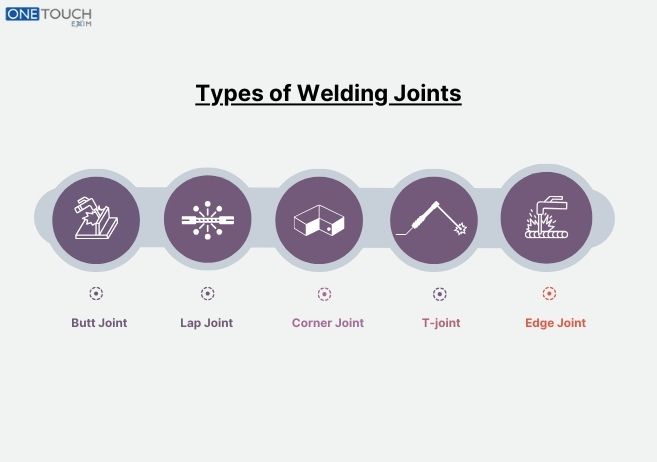The welding joints are the arrangement of two or more metal counterparts that are arranged to be fused together by welding. The joints are a governing factor in the strength, integrity, and overall efficiency of a fused methodology, amongst several other characteristics. The joint type is dependent upon a variety of factors, including the design required, the substrate thickness of the material to be joined together, load condition, and accessibility for the welding process. There are five types of possible welding joints when welding fabrication or construction.
Understanding welding joints: An in-Depth Guide
Weld joints are the connections that hold metal parts together and are very important to the strength, durability, and overall structural integrity in construction and fabrication efforts. There are different kinds of joints, each meeting distinct criteria depending on the load, alignment, and type of application intended. Selecting and performing welding joints properly will assure you safe and functional work pieces, while also reducing material waste and leading to more efficient fabrication procedures.
Types of Welding Joints:
- Butt joint:
Of the many and varied welding joints, the buttjoint is the most common and frequently used, occurring where two metals are placed in the same plane and joined at the edges. In design, butt joints are simply a join consisting of butting two edges and welding along the seam. Butt joints are low in cost, offer great flexibility of use, and are simple to execute in fabrication, manufacturing, and structural welding. A butt joint can be any type of joint that is welded, and some welding processes can be used, such as MIG, TIG, or arc welding, depending on the project requirements. Butt joints add little to no shape to the object or surface.
- Lap joint:
Lap joints are one of the simplest and most common joints in wood and metalworking. They can easily be put together quickly and have good strength and bonding capabilities. A lap joint consists of two components of material that overlap each other and are held together, typically by a method such as welding, gluing, or fastening with nails, screw, or bolts. A lap joint can be presented as a full lap joint, which does not alter thickness, and a half lap joint, where some thickness is cut off so the pieces are flush with each other. A lap joint, while not necessarily complex, can provide significant loads, and it can be easily reinforced with mechanical fasteners or adhesives.
- Corner joints:
Corner joints are one of the welding joints frequently used for manufacturing frames, boxes, and other structures consisting of two parts of metal meeting at right angles. For these joints, the edges of the workpieces are brought together to form an “L” shape, typically at 90 degrees. Corner joints are frequently used in metalwork. The corner joint can be welded with the available welding methods, such as MIG, TIG, or arc welding, depending on the material and required durability strength.
- T-joint:
In welding, T-joints are formed when two sections of metal are joined together at 90 degrees from each other, so as to form a “T” shape. T-joints are commonly structural and heavy-duty applications. Because they allow one component to be connected to another perpendicularly. A T-joint can be welded in a number of ways, depending on the strength requirements and the final appearance of the weld, including either a fillet weld, plug weld, or slot weld. T-joint welds have a significant amount to offer in both light and heavy-duty situations to provide high strength and integrity.
- Edge joint:
A welded edge joint is formed by putting the edge of two or more metal plates either side by side or sometimes stacked on the thickness and welding them together. This type of welded joint is most commonly used where the joint component may not have a heavy load to resist; instead, the strength of the joints principally comes from the weld bead to hold the part together, not the thickness of the material. The welding of an edge joint is most commonly found in sheet metal work, light fabrication, and in items where it is desired to join and not to provide structural strength, or more for reinforcement of box-type construction, where there is no specific load to resist.
Uses of Welding Joints:
- Butt Joint is also used in construction applications, such as pipelines, pressure vessels, frames, and structural applications. Butt joints are often used in the manufacturing of automobiles or parts of the aircraft industry because of the stresses they can handle.
- Lap joints are widely used in metalworking, woodworking, structural construction, piping systems, and advanced composites because they have resistance to racking, ease of fabrication.
- Corner joints are commonly used in automotive work, enclosures, sheet metal fabrication, storage tanks, and frames or structures. Because they provide strength, distortion control, and stress loading.
- T-joints are used in shipbuilding or marine structures, machinery, or equipment, and structural fabrication, or architectural metalwork. Because of the load transfer, ease of welding, versatility, and mechanical strength.
- Edge joints are used to connect thin materials like tanks and enclosures, mufflers, lightweight parts, and surface creation. The edge joint is suitable are these applications because of the thin material compatibility and heat control.
Conclusion
In conclusion, welding joints are crucial in fabrication, construction, and manufacturing for a reliable connection of joined metals. When utilized for either intended use, welding joints offer structures strength, safety of operation, and longevity from pipelines, automotive components, buildings, and heavy equipment. Welding joints are completely defect-free and will perform properly if the method design requirements and safety are explored. Having a good understanding of their application, design, and limitations of welding joints helps engineers and fabricators choose the best method to achieve adequate performance and life from their design.
